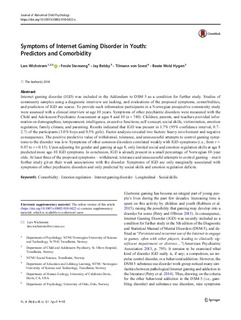| dc.contributor.author | Wichstrøm, Lars | |
| dc.contributor.author | Stenseng, Frode | |
| dc.contributor.author | Belsky, Jay | |
| dc.contributor.author | von Soest, Tilmann | |
| dc.contributor.author | Hygen, Beate Wold | |
| dc.date.accessioned | 2018-08-30T07:22:03Z | |
| dc.date.available | 2018-08-30T07:22:03Z | |
| dc.date.created | 2018-06-29T13:42:12Z | |
| dc.date.issued | 2018 | |
| dc.identifier.citation | Journal of Abnormal Child Psychology. 2018, 1-13. | nb_NO |
| dc.identifier.issn | 0091-0627 | |
| dc.identifier.uri | http://hdl.handle.net/11250/2559965 | |
| dc.description.abstract | Internet gaming disorder (IGD) was included in the Addendum to DSM-5 as a condition for further study. Studies of community samples using a diagnostic interview are lacking, and evaluations of the proposed symptoms, comorbidities, and predictors of IGD are scarce. To provide such information participants in a Norwegian prospective community study were assessed with a clinical interview at age 10 years. Symptoms of other psychiatric disorders were measured with the Child and Adolescent Psychiatric Assessment at ages 8 and 10 (n = 740). Children, parents, and teachers provided information on demographics, temperament, intelligence, executive functions, self-concept, social skills, victimization, emotion regulation, family climate, and parenting. Results indicated that IGD was present in 1.7% (95% confidence interval, 0.7–2.7) of the participants (3.0% boys and 0.5% girls). Factor analysis revealed two factors: heavy involvement and negative consequences. The positive predictive value of withdrawal, tolerance, and unsuccessful attempts to control gaming symptoms to the disorder was low. Symptoms of other common disorders correlated weakly with IGD-symptoms (i.e., from r = 0.07 to r = 0.15). Upon adjusting for gender and gaming at age 8, only limited social and emotion regulation skills at age 8 predicted more age-10 IGD symptoms. In conclusion, IGD is already present in a small percentage of Norwegian 10-year olds. At least three of the proposed symptoms -- withdrawal, tolerance and unsuccessful attempts to control gaming -- merit further study given their weak associations with the disorder. Symptoms of IGD are only marginally associated with symptoms of other psychiatric disorders and only predicted by social skills and emotion regulation deficits. | nb_NO |
| dc.language.iso | eng | nb_NO |
| dc.publisher | Springer Verlag | nb_NO |
| dc.rights | Navngivelse 4.0 Internasjonal | * |
| dc.rights.uri | http://creativecommons.org/licenses/by/4.0/deed.no | * |
| dc.title | Symptoms of Internet Gaming Disorder in Youth: Predictors and Comorbidity | nb_NO |
| dc.type | Journal article | nb_NO |
| dc.type | Peer reviewed | nb_NO |
| dc.description.version | publishedVersion | nb_NO |
| dc.source.pagenumber | 1-13 | nb_NO |
| dc.source.journal | Journal of Abnormal Child Psychology | nb_NO |
| dc.identifier.doi | 10.1007/s10802-018-0422-x | |
| dc.identifier.cristin | 1594788 | |
| dc.relation.project | Norges forskningsråd: 240097 | nb_NO |
| dc.relation.project | Norges forskningsråd: 228685 | nb_NO |
| dc.relation.project | Samarbeidsorganet mellom Helse Midt-Norge og NTNU: 000 | nb_NO |
| dc.description.localcode | (C) The Author(s) 2018. This article is distributed under the terms of the Creative Commons Attribution 4.0 International License (http://creativecommons.org/licenses/by/4.0/) | nb_NO |
| cristin.unitcode | 194,67,40,0 | |
| cristin.unitcode | 194,67,70,0 | |
| cristin.unitname | Institutt for psykologi | |
| cristin.unitname | Institutt for pedagogikk og livslang læring | |
| cristin.ispublished | true | |
| cristin.fulltext | original | |
| cristin.qualitycode | 2 | |

